2.3 Hydrography
2.3.1 Water Tanks
2.3.1.1 Example 1
| |
| Location of Example: |
152°20'25" East, 25°51'04" South |
| Distinctive Characteristics: |
- Water Towers appear as circular elevated features. This is evident by the shadow signature.
- Water Tanks/Water Towers are typically found in residential/urban areas, unlike Storage Tanks which are typically found in industrial/commercial areas.
- Water Tanks/Water Towers tend to be solitary, unlike Storage Tanks that are typically concentrated in one area.
|
| Regional Considerations: |
|
| Figure: 2.3.1.1 Representation of Water Tanks |
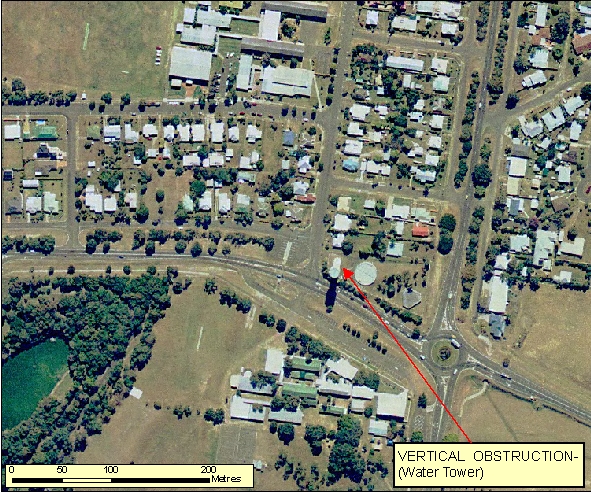
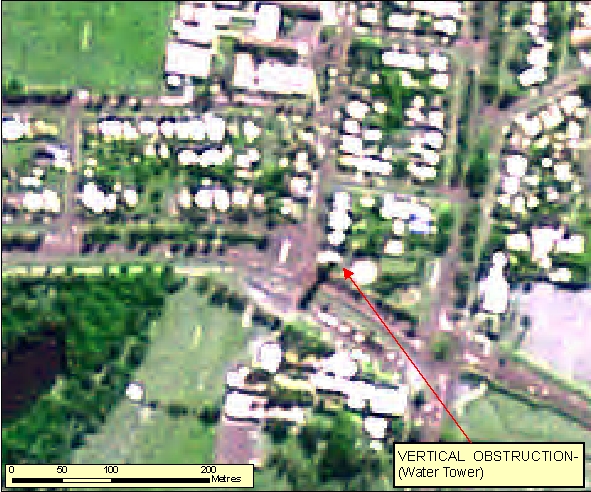
[back to top]
2.3.1.2 Example 2
| |
| Location of Example: |
| Distinctive Characteristics: |
- Water Towers are of various constructions as per Figure: 2.3.1.2.
- Water Towers are typically located within or nearby Population Centres, they are significant topographic features because of their height.
|
| Regional Considerations: |
|
| Figure: 2.3.1.2 Photographs of Water Towers. |
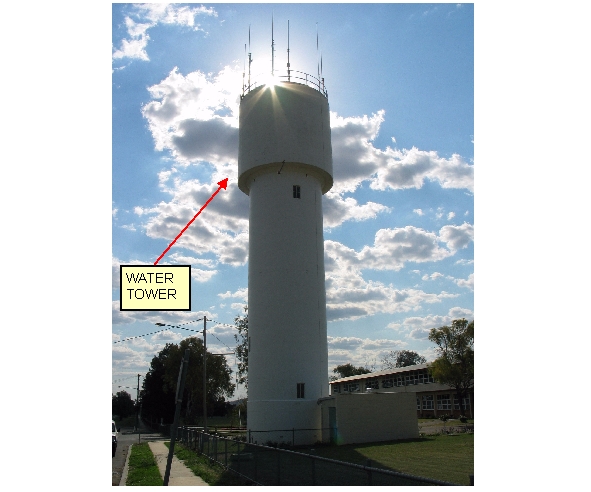
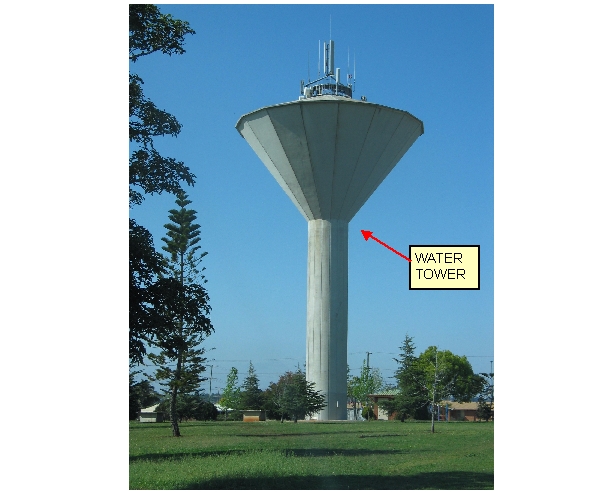
[back to top]
2.3.1.3 Example 3
| |
| Location of Example: |
152°41'50" East, 25°32'38" South |
| Distinctive Characteristics: |
- Water Towers appear as circular elevated features. This is evident by the shadow signature.
- Water Tanks/Water Towers are typically found in residential/urban areas, unlike Storage Tanks which are typically found in industrial/commercial areas.
- Water Tanks/Water Towers tend to be solitary, unlike Storage Tanks that are typically concentrated in one area.
- Water Towers are typically found in flat areas, the tower is required to be elevated to provide water pressure.
- Water Towers may have additional structures mounted on top.
|
| Regional Considerations: |
|
| Figure: 2.3.1.3 Representation of Water Tanks |
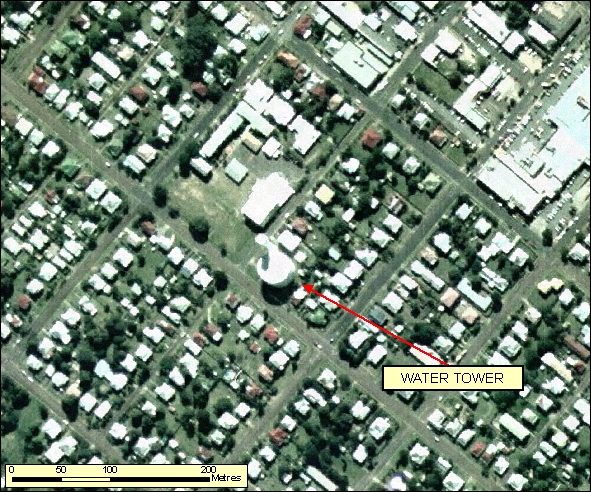
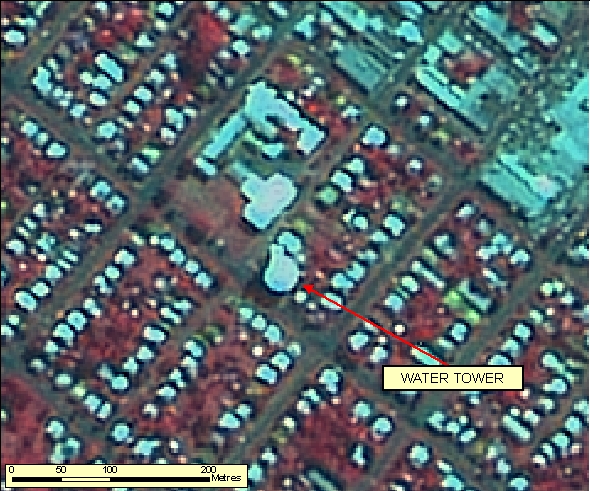
[back to top]
2.3.1.4 Example 4
| |
| Location of Example: |
146°3'30" East, 34°16'40" South |
| Distinctive Characteristics: |
- Water Tanks appear as circular structure not situated on a tower.
- Water Tanks/Water Towers are typically found in residential/urban areas, unlike Storage Tanks which are typically found in industrial/commercial areas.
- Water Tanks/Water Towers tend to be solitary, unlike Storage Tanks that are typically concentrated in one area.
|
| Regional Considerations: |
|
| Figure: 2.3.1.4 Representation of Water Tanks |
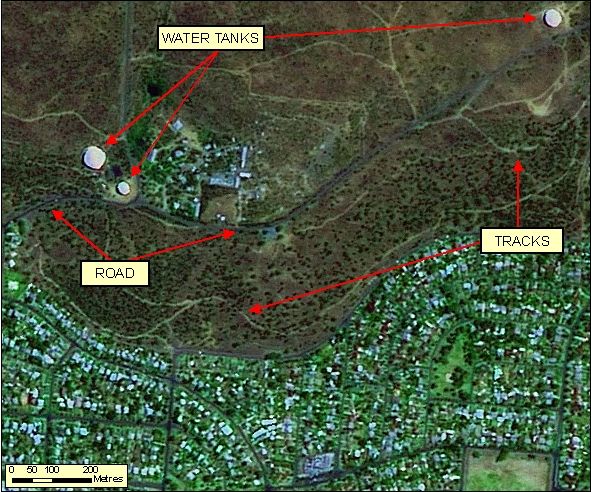
[back to top]
2.3.2 Canals
2.3.2.1 Example 1
| |
| Location of Example: |
150°8'45" East, 28°25'41" South |
| Distinctive Characteristics: |
- Drains/Canals can be differentiated from Roads as they do not provide connectivity to the existing road network.
- If the Drain/Canal is completely dry it will appear lighter, similar to the surrounding soil and vegetation. The edges will often appear much lighter, due to the excavated soil from construction.
- Drains generally start at a water source and can end at a Reservoir, Dam or Sea.
- Drains follow the topography of the land whereas roads may traverse hills and valleys.
- In Figure 2.3.2.1a the canals appear as dark blue linear bodies when filled with water.
- The use of mulitspectral imagery band combinations can aid in the interpretation and differentiation of water.
|
| Regional Considerations: |
- In areas where there is irrigated crop farming Canals/Drains appear as regular structured networks which show a water flow hierarchy diminishing from source. They are often aligned with paddocks and have access tracks or roads running parallel to them.
|
| Figure: 2.3.2.1 Representation of Canals |
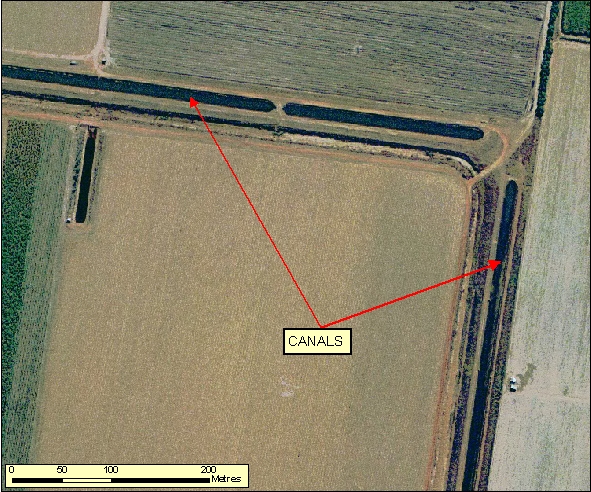
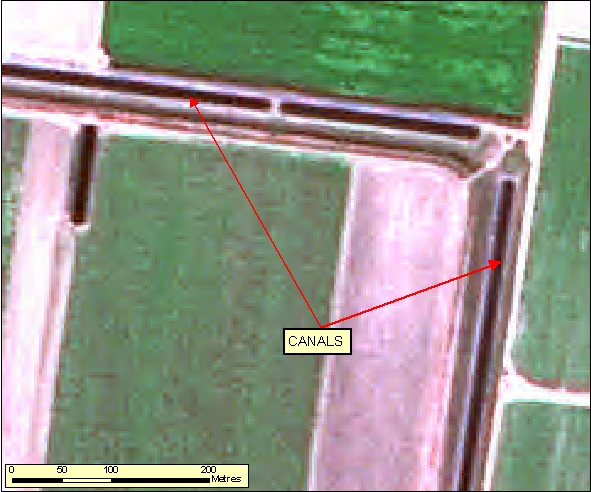
[back to top]
2.3.2.2 Example 2
| |
| Location of Example: |
152°52'19" East, 25°22'57" South |
| Distinctive Characteristics: |
- Drains/Canals can be differentiated from Roads as they do not provide connectivity to the existing road network.
- In Figure: 2.3.2.2b note that the upper part of the drain near the water source gives off a light blue signature, indicating presence of water. The drain terminates at the water tank which also shows the same water signature.
- If the Drain/Canal is completely dry it will appear lighter, similar to the surrounding soil and vegetation. The edges will often appear much lighter, due to the excavated soil from construction.
- Drains generally start at a water source and can end at a Reservoir, Dam or Sea.
- Drains follow the topography of the land whereas roads may traverse hills and valleys.
- The use of mulitspectral imagery band combinations can aid in the interpretation and differentiation of water.
|
| Regional Considerations: |
|
| Figure: 2.3.2.2 Representation of Canals |
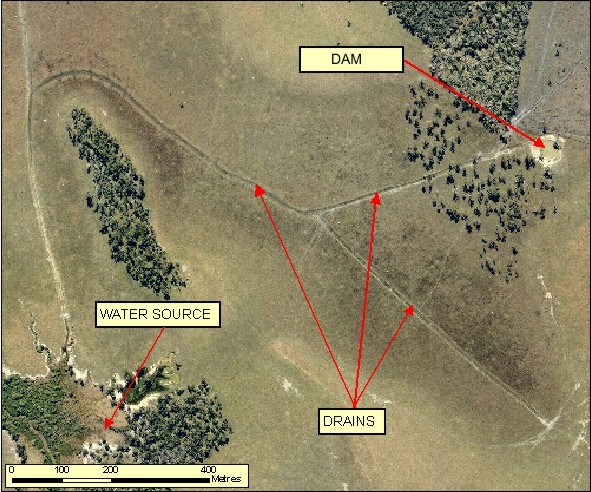
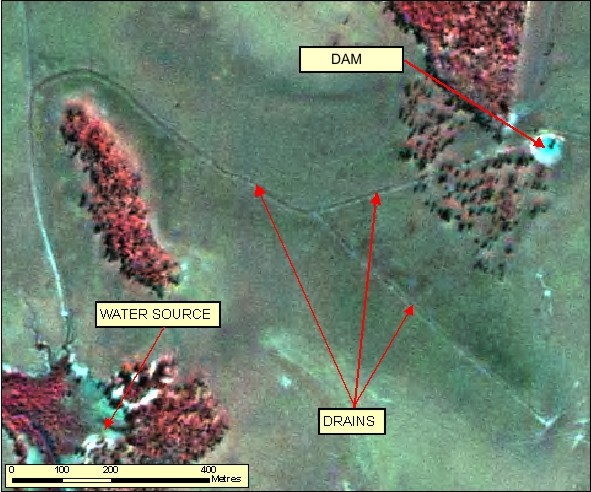
[back to top]
2.3.2.3 Example 3
| |
| Location of Example: |
149°33'42" East, 28°37'13" South |
| Distinctive Characteristics: |
- Drains/Canals can be differentiated from Roads as they do not provide connectivity to the existing road network.
- If the Drain/Canal is completely dry it will appear lighter, similar to the surrounding soil and vegetation. The edges will often appear much lighter, due to the excavated soil from construction.
- Drains generally start at a water source and can end at a Reservoir, Dam or Sea.
- Drains follow the topography of the land whereas roads may traverse hills and valleys.
- The use of mulitspectral imagery band combinations can aid in the interpretation and differentiation of water.
|
| Regional Considerations: |
- In areas where there is irrigated crop farming Canals/Drains appear as regular structured networks which show a water flow hierarchy diminishing from source. They are often aligned with paddocks and have access tracks or roads running parallel to them.
|
| Figure: 2.3.2.3 Representation of Canals in association with surrounding features. |
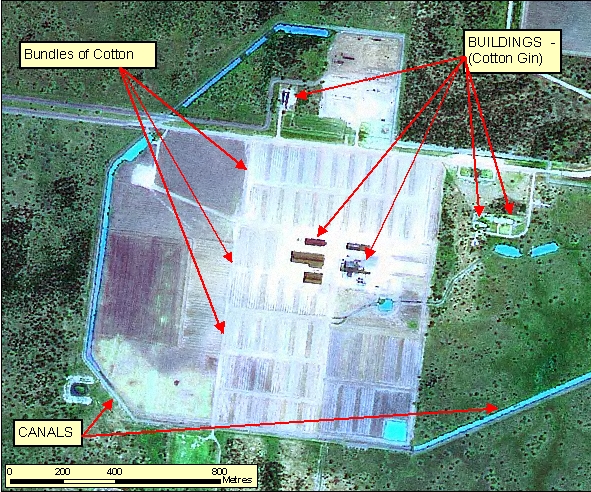
[back to top]
2.3.2.4 Example 4
| |
| Location of Example: |
|
| Distinctive Characteristics: |
- This is an example of a large Canal partially filled with water used for the purpose of Flood Irrigation in regional New South Wales. Note the width, depth and length of this Canal.
|
| Regional Considerations: |
|
| Figure: 2.3.2.4 Photograph of a Canal |
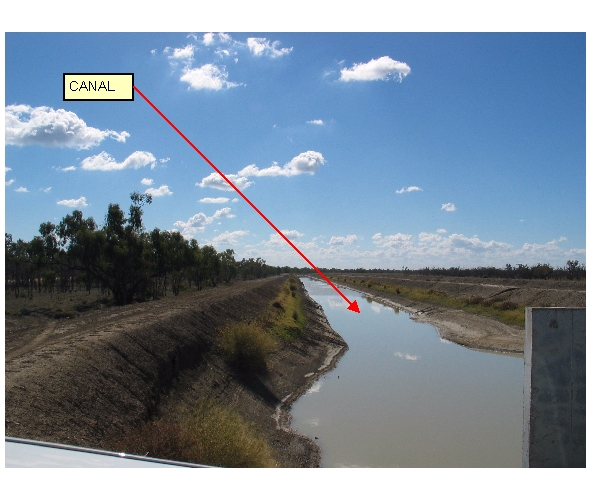
[back to top]
2.3.2.5 Example 5
| |
| Location of Example: |
150°8'43" East, 28°27'8" South |
| Distinctive Characteristics: |
- Drains/Canals can be differentiated from natural watercourses by their linear structure.
- Natural Watercourses can be differentiated from Drain/Canals by remnant vegetation adjacent to stream path.
- Drains/Canals can be differentiated from Roads as they do not provide connectivity to the existing road network.
- If the Drain/Canal is completely dry it will appear lighter, similar to the surrounding soil and vegetation. The the edges will often appear much lighter, due to the excavated soil from construction.
- Drains generally start at a water source and can end at a Reservoir, Dam or Sea.
- Drains follow the topography of the land whereas roads may traverse hills and valleys.
- The use of mulitspectral imagery band combinations can aid in the interpretation and differentiation of water.
|
| Regional Considerations: |
- In areas where there is irrigated crop farming Canals/Drains appear as regular structured networks which show a water flow hierarchy diminishing from source. They are often aligned with paddocks and have access tracks or roads running parallel to them.
|
| Figure: 2.3.2.5 Representation of Canals in association with surrounding features. |
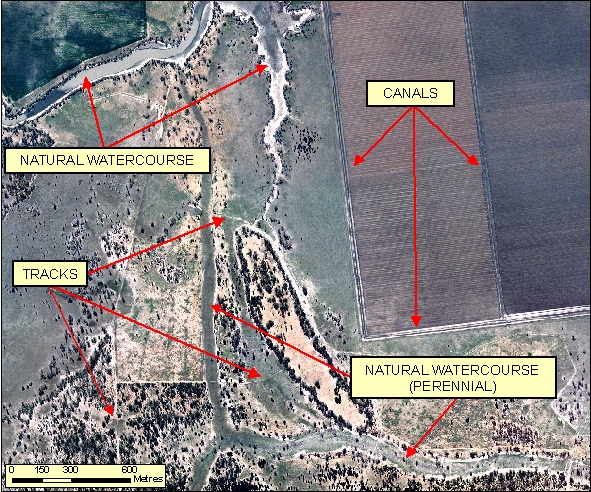
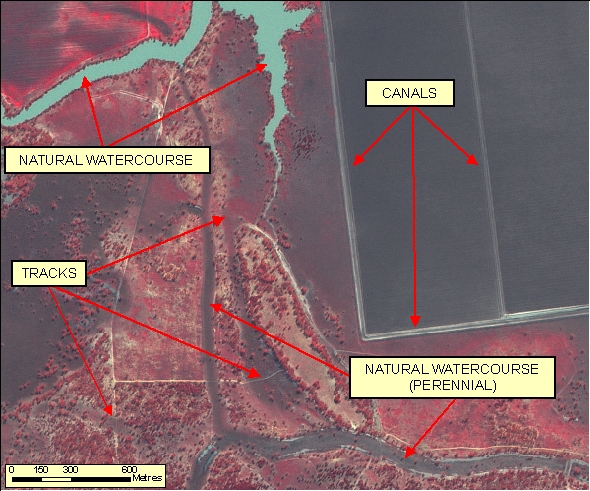
[back to top]
2.3.2.6 Example 6
| |
| Location of Example: |
149°57'7" East, 28°30'42" South |
| Distinctive Characteristics: |
- Drains/Canals can be differentiated from natural watercourses by their linear structure.
- Natural Watercourses can be differentiated from Drain/Canals by remnant vegetation adjacent to stream path.
- Drains/Canals can be differentiated from Roads as they do not provide connectivity to the existing road network.
- If the Drain/Canal is completely dry it will appear lighter, similar to the surrounding soil and vegetation. The the edges will often appear much lighter, due to the excavated soil from construction.
- Drains generally start at a water source and can end at a Reservoir, Dam or Sea.
- Drains follow the topography of the land whereas roads may traverse hills and valleys.
- The use of mulitspectral imagery band combinations can aid in the interpretation and differentiation of water.
|
| Regional Considerations: |
- In areas where there is irrigated crop farming Canals/Drains appear as regular structured networks which show a water flow hierarchy diminishing from source. They are often aligned with paddocks and have access tracks or roads running parallel to them.
|
| Figure: 2.3.2.6 Representation of Canals in association with surrounding features. |
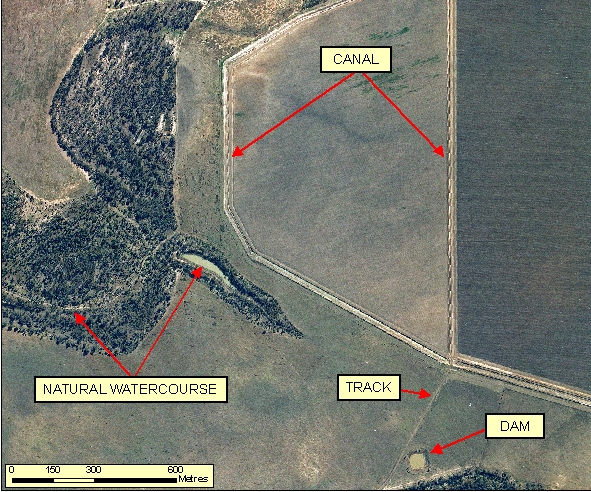
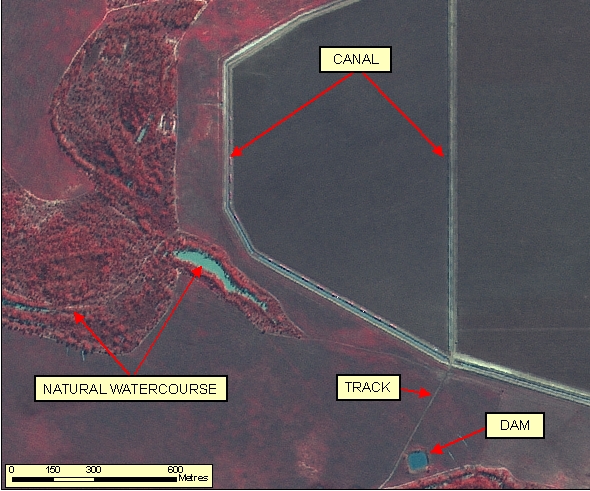
[back to top]
2.3.2.7 Example 7
| |
| Location of Example: |
147°16'19" East, 20°05'56" South |
| Distinctive Characteristics: |
- Drains/Canals can be differentiated from natural watercourses by their linear structure.
- Natural Watercourses can be differentiated from Drain/Canals by remnant vegetation adjacent to stream path.
- Drains/Canals can be differentiated from Roads as they do not provide connectivity to the existing road network.
- If the Drain/Canal is completely dry it will appear lighter, similar to the surrounding soil and vegetation. The the edges will often appear much lighter, due to the excavated soil from construction.
- Drains generally start at a water source and can end at a Reservoir, Dam or Sea.
- Drains follow the topography of the land whereas roads may traverse hills and valleys.
- The use of multispectral imagery band combinations can aid in the interpretation and differentiation of water.
|
| Regional Considerations: |
- In areas where there is irrigated crop farming Canals/Drains appear as regular structured networks which show a water flow hierarchy diminishing from source. They are often aligned with paddocks and have access tracks or roads running parallel to them.
|
| Figure: 2.3.2.7 Representation of Canals in association with surrounding features. |
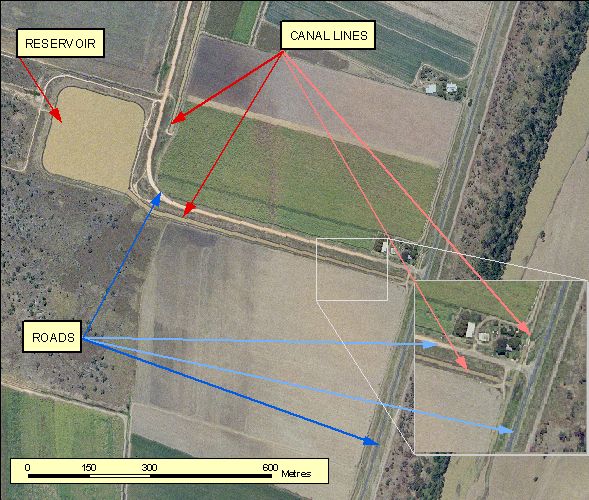
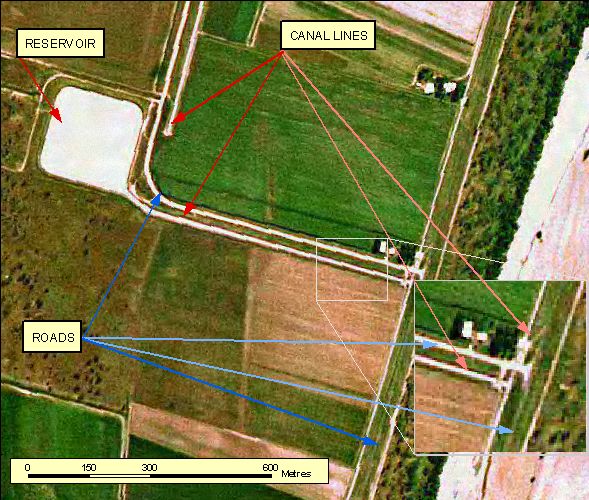
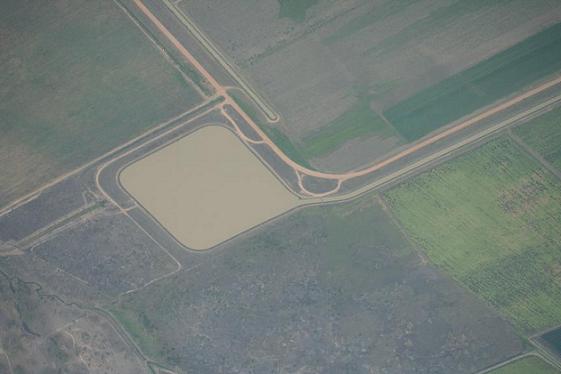
[back to top]
2.3.3 Pondage Areas
2.3.3.1 Example 1
| |
| Location of Example: |
152°06'32" East, 24°47'52" South |
| Distinctive Characteristics: |
- Aquaculture Areas are typically more frequent and smaller in size compared to Settling Ponds.
- Aquaculture Areas can be differentiated from Settling Ponds due to their proximity to other features such as town rural water supply, whereas Settling Ponds are rarely found near Town Rural Storage Reservoirs.
- Aquaculture Areas are easily identified on imagery due to their rectangular or geometric shapes.
|
| Regional Considerations: |
|
| Figure: 2.3.3.1 Representation of Aquaculture Areas. |
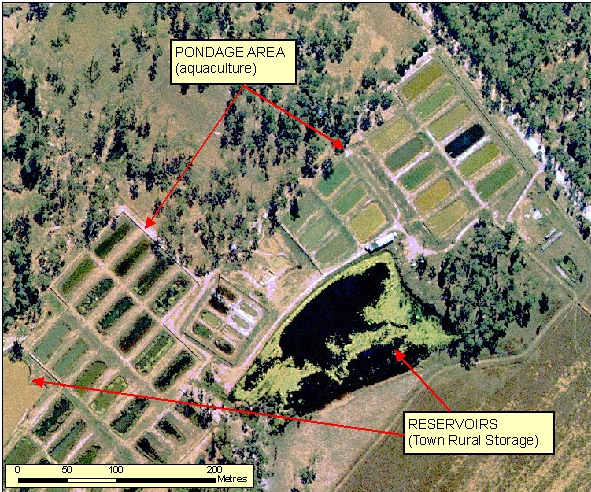

[back to top]
2.3.3.2 Example 2
| |
| Location of Example: |
152°06'13" East, 24°37'02" South |
| Distinctive Characteristics: |
- Aquaculture Areas are typically more frequent and smaller in size compared to Settling Ponds.
- Aquaculture Areas can be differentiated from Settling Ponds due to their proximity to other features such as town rural water supply, whereas Settling Ponds are rarely found near Town Rural Storage Reservoirs.
- Aquaculture Areas are easily identified on imagery due to their rectangular or geometric shapes.
|
| Regional Considerations: |
|
| Figure: 2.3.3.2 Representation of Aquaculture Areas. |
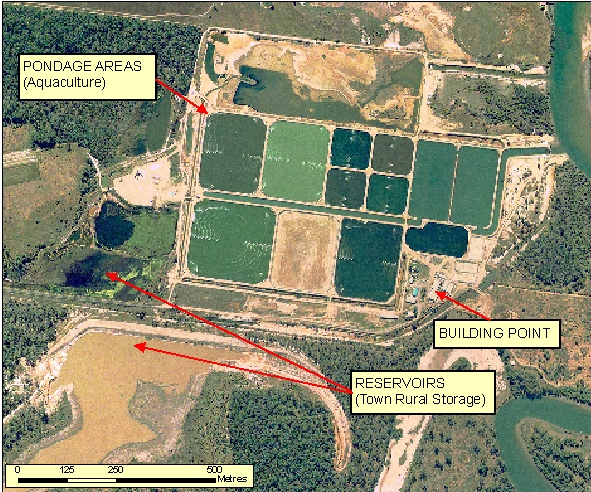
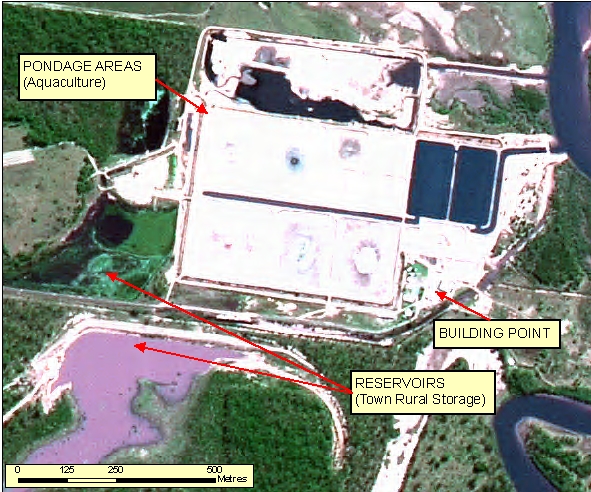
[back to top]
2.3.3.3 Example 3
| |
| Location of Example: |
152°48'59" East, 25°16'23" South |
| Distinctive Characteristics: |
- Settling Ponds appear on imagery as large geometric shaped ponds separated by levees.
- Sewage Settling Ponds may be distinguished from other types of ponds by the presence of the treatment tanks and plant infrastructure.
- Settling Ponds are isolated from the natural hydrological network.
|
| Regional Considerations: |
|
| Figure: 2.3.3.3 Representation of Settling Ponds. |
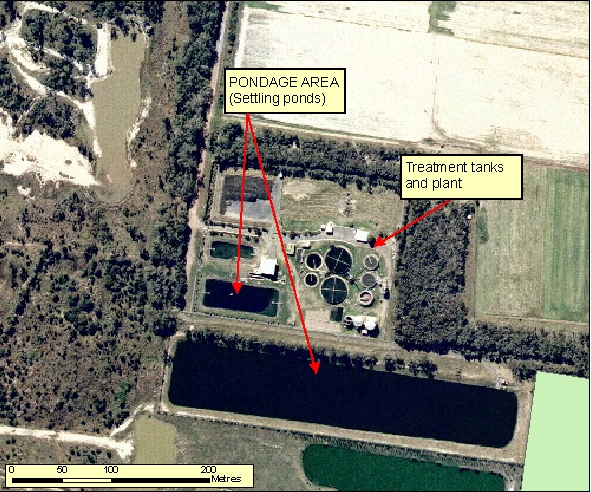
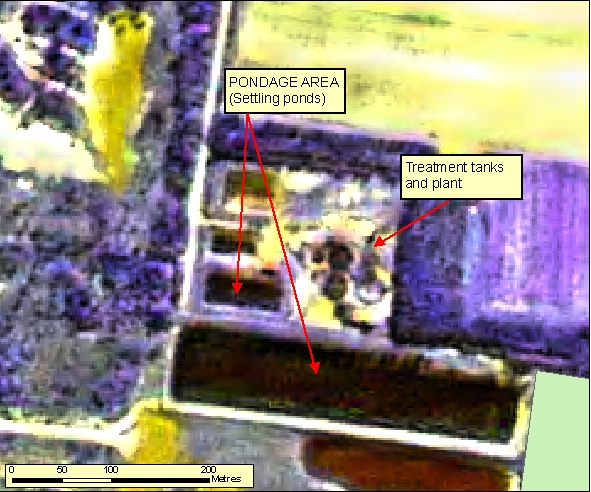
[back to top]
2.3.3.4 Example 4
| |
| Location of Example: |
152°37'08" East, 25°12'40" South |
| Distinctive Characteristics: |
- Settling Ponds appear on imagery as large geometric shaped ponds separated by levees.
- Sewage Settling Ponds may be distinguished from other types of ponds by the presence of the treatment tanks and plant infrastructure.
- Settling Ponds are isolated from the natural hydrological network.
|
| Regional Considerations: |
|
| Figure: 2.3.3.4 Representation of Settling Ponds. |
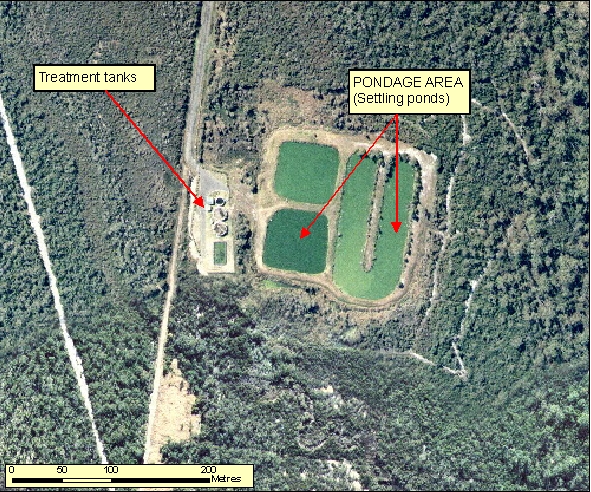
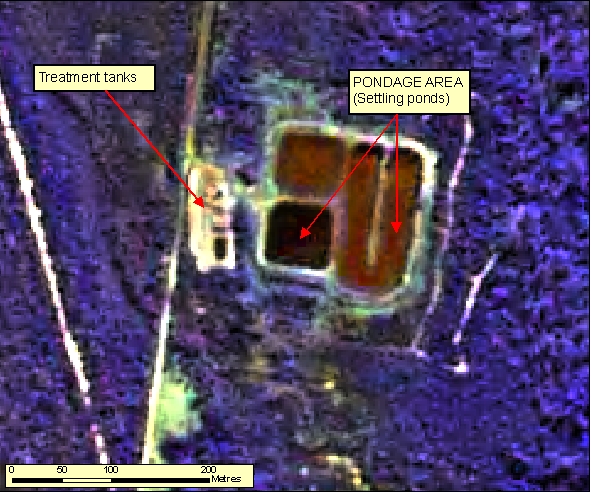
[back to top]
2.3.3.5 Example 5
| |
| Location of Example: |
144°12'09" East, 35°21'36" South |
| Distinctive Characteristics: |
- Figure 2.3.3.5 is an example of a Salt Evaporator.
- Ground, Bore or Sea water is pumped into large ponds to enable the water to be evaporated by the sun leaving the salt behind.
- Salt Evaporators may be differentiated from Aquaculture by the varied sizes of smaller beds with irregular edges located within a larger grid pattern.
- Salt has a distinctive imagery signature in comparison to the surrounding environment.
|
| Regional Considerations: |
- Salt Evaporators will only be found in areas of low rainfall and high solar intensity.
- Salt Evaporators will be characteristically located on flat terrain.
|
| Figure: 2.3.3.5 Representation of a Salt Evaporator. |
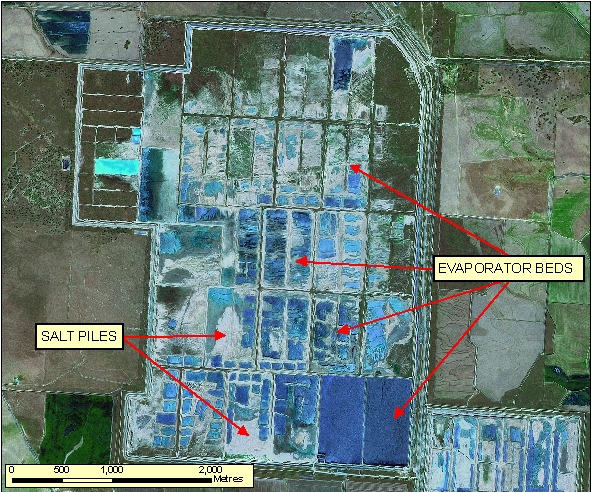
[back to top]
2.3.3.6 Example 6
| |
| Location of Example: |
153°01'50" East, 26°45'52" South |
| Distinctive Characteristics: |
- Aquaculture Areas are typically more frequent and smaller in size compared to Settling Ponds.
- Aquaculture Areas can be differentiated from Settling Ponds due to their proximity to other features such as town rural water supply, whereas Settling Ponds are rarely found near Town Rural Storage Reservoirs.
- Aquaculture Areas are easily identified on imagery due to their rectangular or geometric shapes.
- As illustrated in Figure 2.3.3.6a the ponds increase marginally in size to accommodate the growth and maturity of the aquatic species.
|
| Regional Considerations: |
|
| Figure: 2.3.3.6 Representation of an Aquaculture Area. |
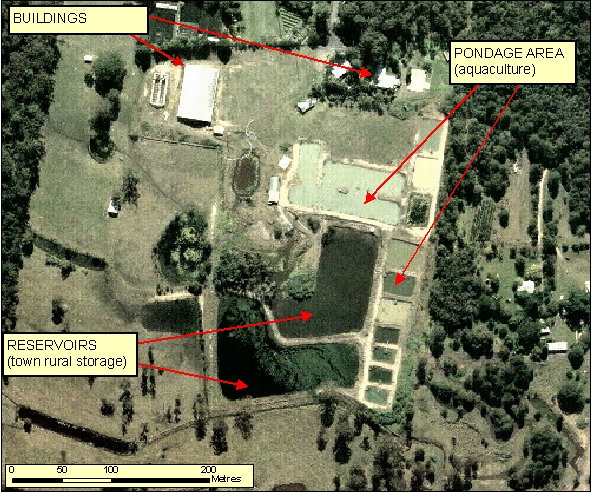
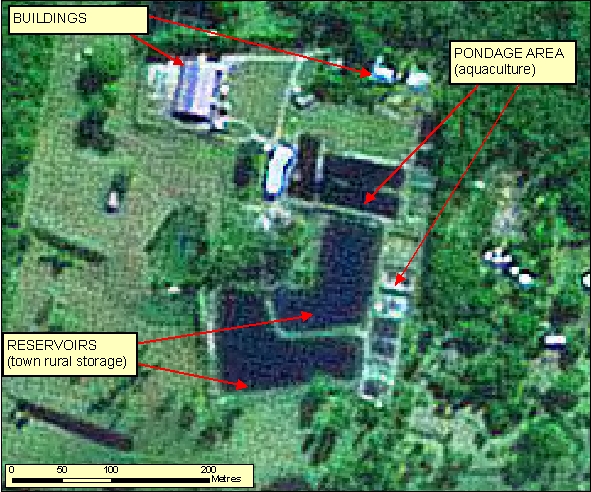
[back to top]
2.3.3.7 Example 7
| |
| Location of Example: |
143°48'30" East, 35°39'16" South |
| Distinctive Characteristics: |
- Figure 2.3.3.7 is an example of a Salt Evaporator.
- Ground, Bore or Sea water is pumped into large ponds to enable the water to be evaporated by the sun leaving the salt behind.
- Salt Evaporators may be differentiated from Aquaculture by the varied sizes of smaller beds with irregular edges located within a larger grid pattern.
- Salt has a distinctive imagery signature in comparison to the surrounding environment.
|
| Regional Considerations: |
- Salt Evaporators will only be found in areas of low rainfall and high solar intensity.
- Salt Evaporators will be characteristically located on flat terrain.
|
| Figure: 2.3.3.7 Representation of a Salt Evaporator. |
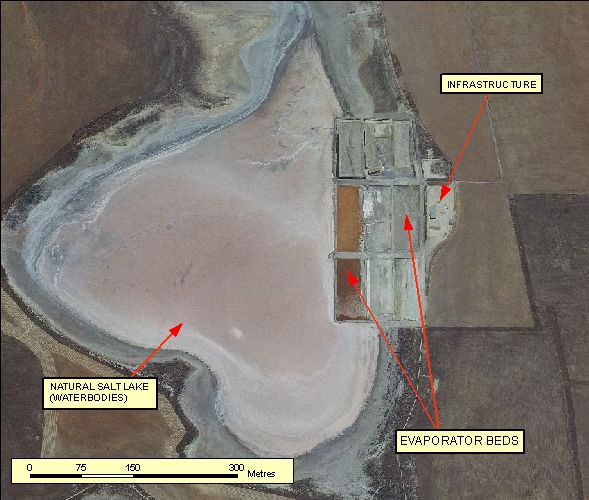
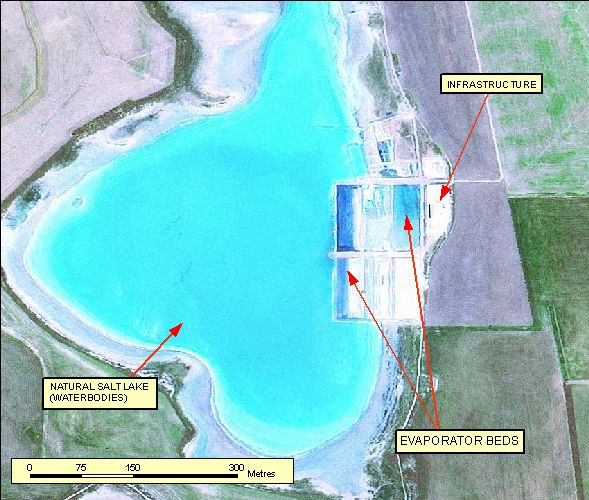
[back to top]
2.3.4 Reservoirs
2.3.4.1 Example 1
| |
| Location of Example: |
152°39'54" East, 25°21'41" South, |
| Distinctive Characteristics: |
- Note the Dam Wall which creates the Reservoir.
- Dam Walls are absent from naturally occurring Lakes.
- Dam Walls can be constructed from both concrete, stone and earthen materials. Each will display a different signature on multispectral imagery.
- Dam Walls may enclose the partial boundary of the Reservoir or its entirety depending on the topography and method of construction of the Reservoir.
|
| Regional Considerations: |
|
| Figure: 2.3.4.1 Representation of a Reservoir in association with surrounding features. |
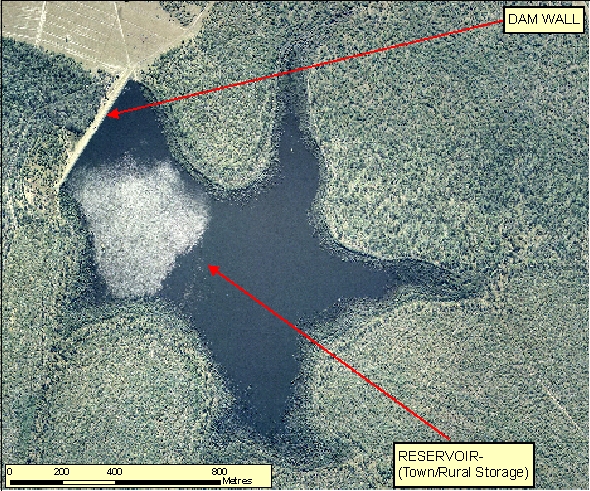
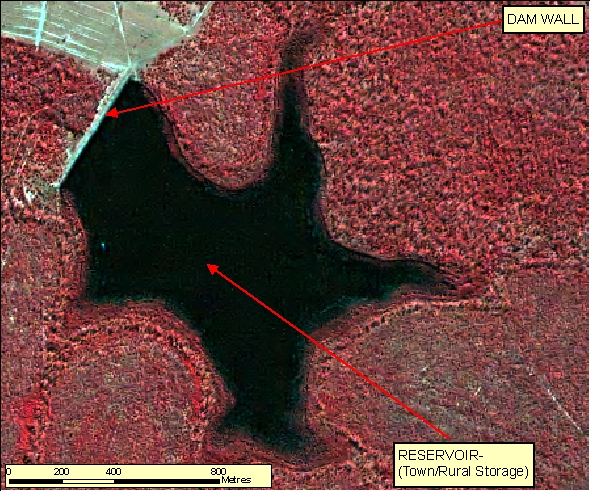
[back to top]
2.3.4.2 Example 2
| |
| Location of Example: |
151°06'32" East, 24°47'52" South, |
| Distinctive Characteristics: |
- Town Rural Storage in this example is being used to provide water to the aquacultural facility and not for human consumption.
- Dam Walls are absent from naturally occurring Lakes.
- Dam Walls can be constructed from both concrete, stone and earthen materials. Each will display a different signature on multispectral imagery.
- Dam Walls may enclose the partial boundary of the Reservoir or its entirity depending on the topography and method of construction of the Reservoir.
|
| Regional Considerations: |
|
| Figure: 2.3.4.2 Representation of a Reservoir in association with surrounding areas. |


[back to top]
2.3.4.3 Example 3
| |
| Location of Example: |
149°35'21" East, 28°35'52" South, |
| Distinctive Characteristics: |
- Large Flood Irrigation Reservoirs can be identified by related infrastructure, such as Cotton Gin facilities that require Flood Irrigation practices.
- Dam Walls are absent from naturally occurring Lakes.
- Dam Walls can be constructed from both concrete, stone and earthen materials. Each will display a different signature on multispectral imagery.
- Dam Walls may enclose the partial boundary of the Reservoir or its entirity depending on the topography and method of construction of the Reservoir.
|
| Regional Considerations: |
|
| Figure: 2.3.4.3 Representation of a Reservoir in association with surrounding features. |
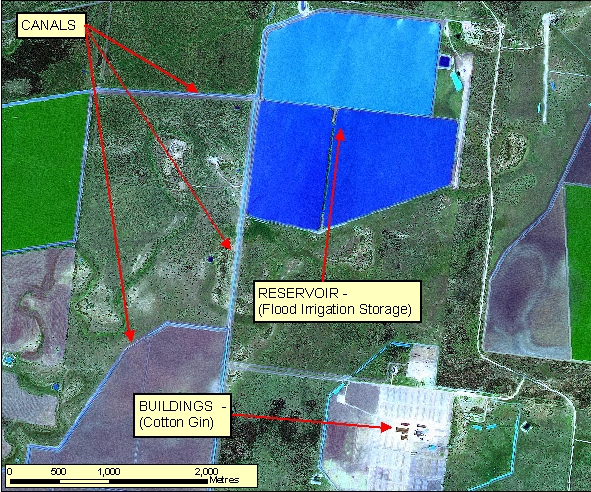
[back to top]
2.3.4.4 Example 4
| |
| Location of Example: |
146°1'54" East, 34°16'31" South, |
| Distinctive Characteristics: |
- Town Rural Storage Reservoirs may be differentiated from Flood Irrigation Storage by their proximity to populated places and it's surrounding landscape use.
- Flood Irrigation Storage typically occurs in low lying areas of intensive agricultural production of cotton and rice.
- Flood Irrigation Storage Reservoirs are typically abutting large fields of intensive agriculture.
- Dam Walls can be constructed from both concrete, stone and earthen materials. Each will display a different signature on multispectral imagery.
- Dam Walls may enclose the partial boundary of the Reservoir or its entirety depending on the topography and method of construction of the Reservoir.
|
| Regional Considerations: |
|
| Figure: 2.3.4.4 Representation of a Reservoir in association with surrounding features. |
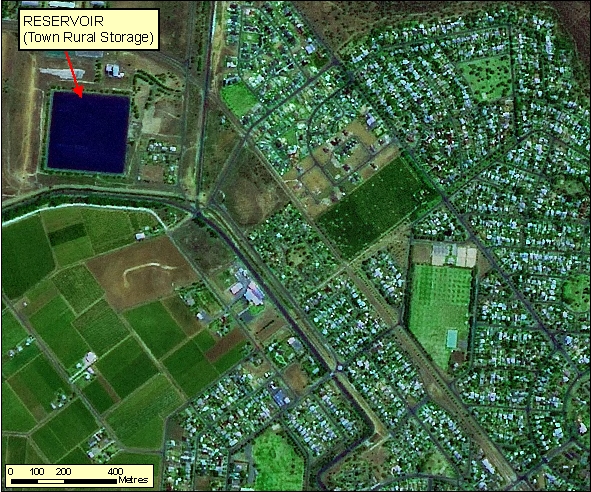
[back to top]
2.3.4.5 Example 5
| |
| Location of Example: |
145°32'20" East, 34°29'36" South, |
| Distinctive Characteristics: |
- Large Flood Irrigation Reservoirs can be identified by related infrastructure, such as Cotton Gin facilities that require Flood Irrigation practices.
- Dam Walls are absent from naturally occurring Lakes.
- Dam Walls can be constructed from both concrete, stone and earthen materials. Each will display a different signature on multispectral imagery.
- Dam Walls may cover the partial boundary of the Reservoir or its entirety depending on the topography and method of construction of the Reservoir.
|
| Regional Considerations: |
|
| Figure: 2.3.4.5 Representation of a Reservoir in association with surrounding features. |
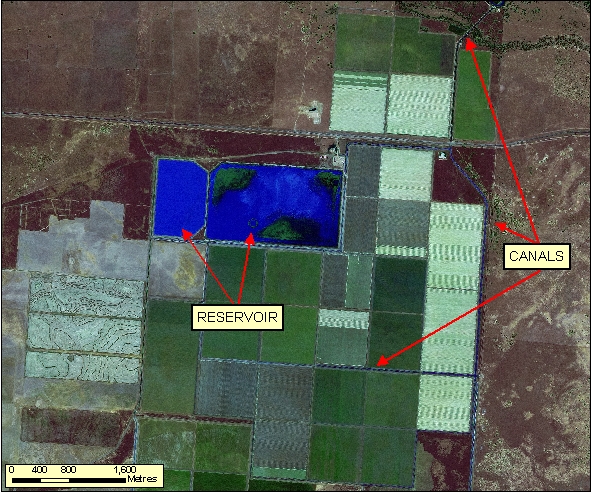
[back to top]
2.3.4.6 Example 6
| |
| Location of Example: |
150°32'28" East, 34°13'44" South, |
| Distinctive Characteristics: |
- This example 2.3.4.6 is an example of what not to capture as a Reservoir.
- There is no evidence of man made barriers, which indicates that these features are natural waterbodies. In the current climate it is possible these waterbodies are part of a river subject to drought. With lower water levels the rivers become segmented and only hold water in the deeper depressions.
|
| Regional Considerations: |
|
| Figure: 2.3.4.6 Representation of a naturally occuring waterbodies which should not be mistaken for a Reservoir. |
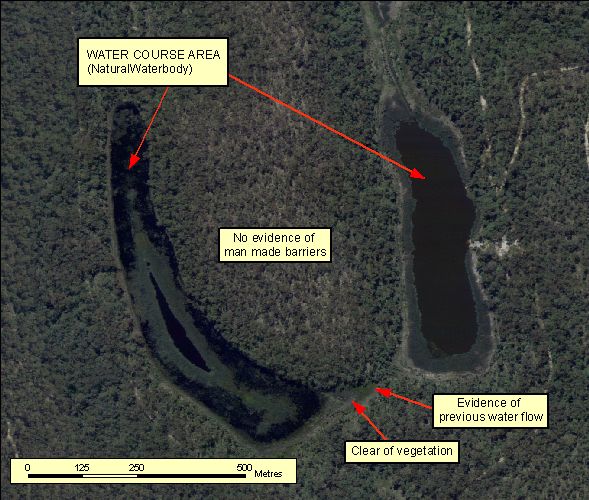
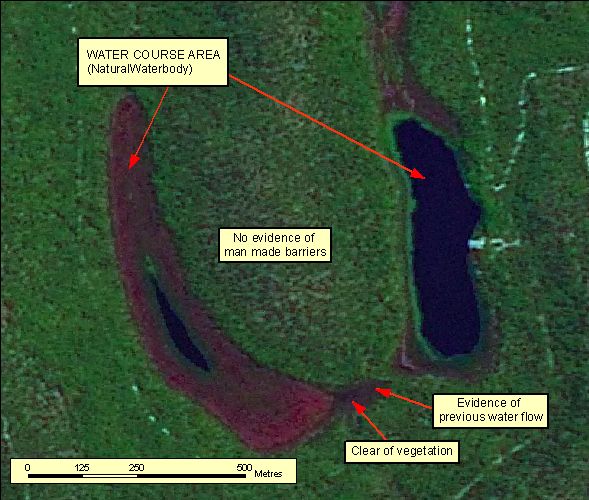
[back to top]
2.3.5 Dams
2.3.5.1 Example 1
| |
| Location of Example: |
144°5'7" East, 35°1'15" South |
| Distinctive Characteristics: |
- Dams can be differentiated from vegetation on thematic imagery by their blue signature compared with the red signature of the vegetation.
- Dams can also be identified by the surrounding earth which was disturbed or displaced during the construction of the Dam. This can aid in distinguishing dry dams from depressions.
- Spectral response may also indicate the presence of water even in a dry dam. In Figure 2.3.5.1 the SPOT imagery indicates a presence of the water with the light/royal blue signature.
|
| Regional Considerations: |
|
| Figure: 2.3.5.1 Representation of Dams |
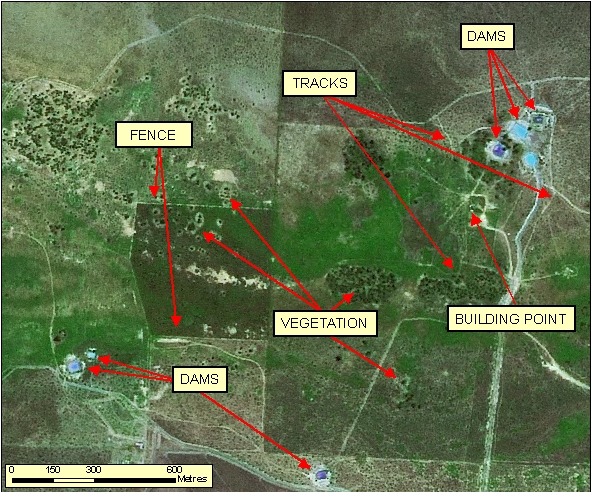
[back to top]
2.3.5.2 Example 2
| |
| Location of Example: |
144°51'59" East, 28°20'30" South |
| Distinctive Characteristics: |
- Dams can be differentiated from vegetation on thematic imagery by their blue signature compared with the red signature of the vegetation.
- Dams can also be identified by the surrounding earth which was disturbed or displaced during the construction of the Dam. This can aid in distinguishing dry dams from depressions.
- Spectral response may also indicate the presence of water even in a dry dam. In Figure 2.3.6.2b the SPOT imagery indicates a presence of the water with the light blue signature.
- Dam Walls can be placed across a natural watercourse to form a Town Rural Storage Reservoir upstream. These type of Reservoirs can be seen by the drying of the natural watercourse downstream and the Dam Wall extending beyond the width of the natural watercourse.
|
| Regional Considerations: |
|
| Figure: 2.3.5.2 Representation of Dams |
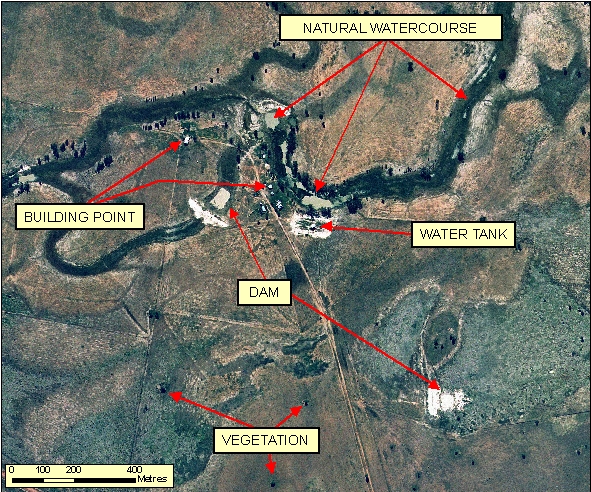
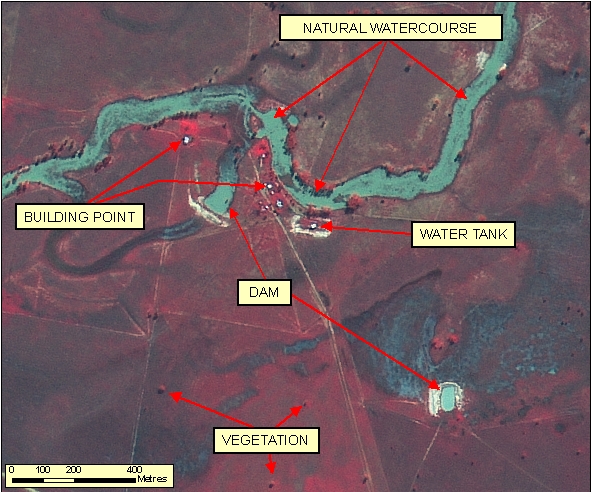
[back to top]
2.3.5.3 Example 3
| |
| Location of Example: |
149°6'00" East, 28°46'14" South |
| Distinctive Characteristics: |
- Dams can be differentiated from vegetation on thematic imagery by their blue signature compared with the red signature of the vegetation.
- Dams can also be identified by the surrounding earth which was disturbed or displaced during the construction of the Dam. This can aid in distinguishing dry dams from depressions.
- Spectral response may also indicate the presence of water even in a dry dam. In Figure 2.3.5.3b the SPOT imagery indicates a presence of the water with the light blue signature.
|
| Regional Considerations: |
|
| Figure: 2.3.5.3 Representation of Dams |
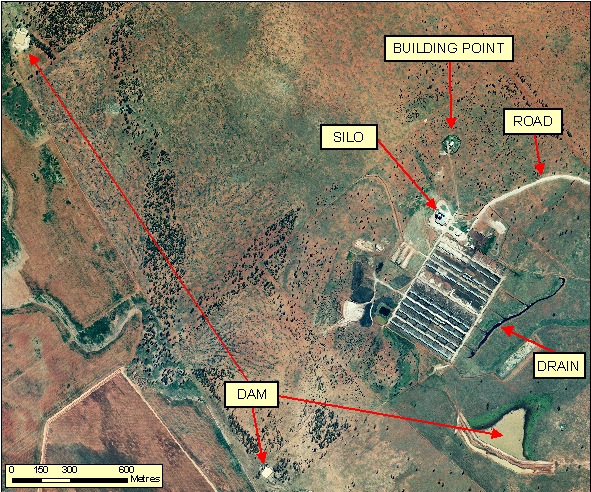
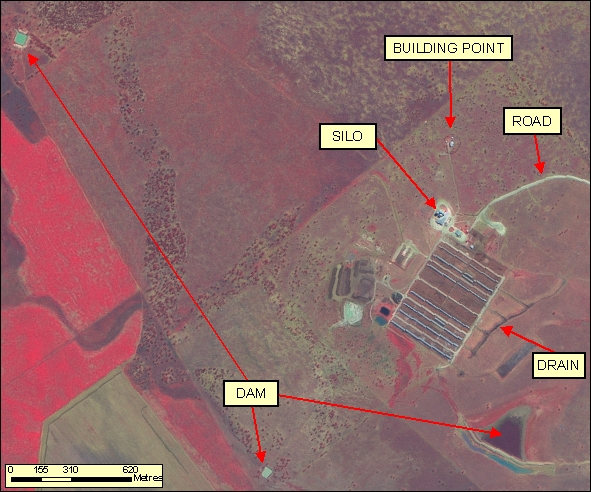
[back to top]
2.3.5.4 Example 4
| |
| Location of Example: |
149°4'28" East, 34°59'50" South |
| Distinctive Characteristics: |
- Dams can be identified by the surrounding earth which was disturbed or displaced during the construction of the Dam. This can aid in distinguishing dry dams from depressions.
- Spectral response may also indicate the presence of water even in a dry dam.
|
| Regional Considerations: |
|
| Figure: 2.3.5.4 Representation of Dams |
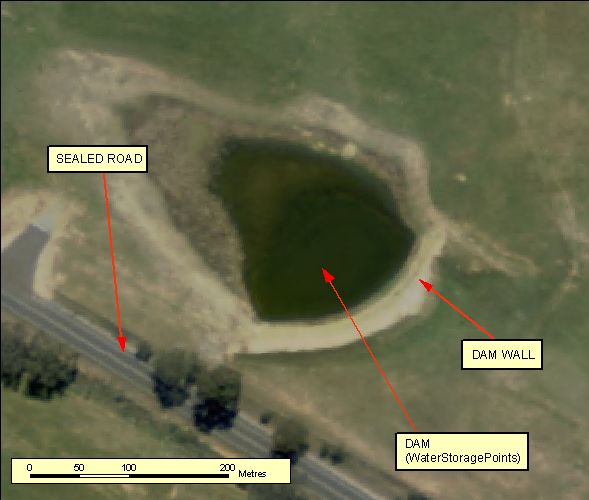
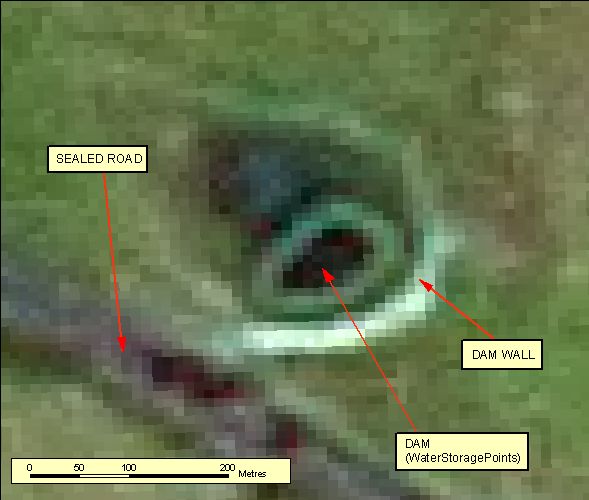
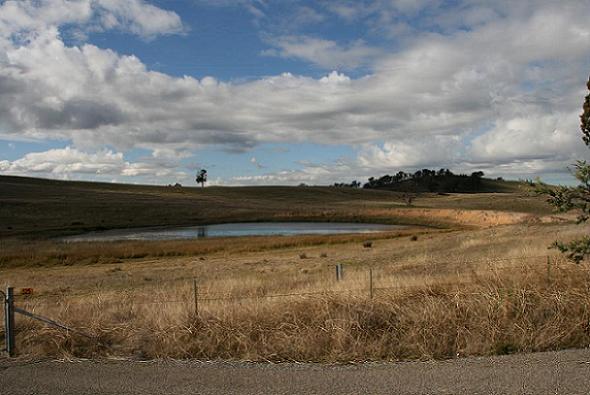
[back to top]
2.3.6 Contour Banks
2.3.6.1 Example 1
| |
| Location of Example: |
151°41'56" East, 27°37'23" South |
| Distinctive Characteristics: |
- Contour banks are earthen structures constructed at intervals across cultivated slopes.
- Contour banks intercept run-off and direct it into nearby Drainage or Waterbodies.
- Contour banks can be identified by the small embankments intercepting the fall of the land.
- Contour banks are not to be captured as Canals.
- Canals generally start at a water source and can end at a Reservoir, Dam or Sea.
- Contour banks differ from Canals as Canals transport water in an active manner (via pumping).
|
| Regional Considerations: |
|
| Figure: 2.3.6.1 Representation of Contour Banks. |
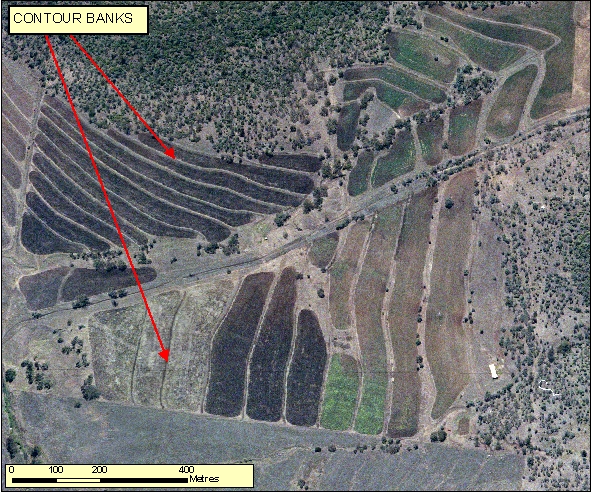
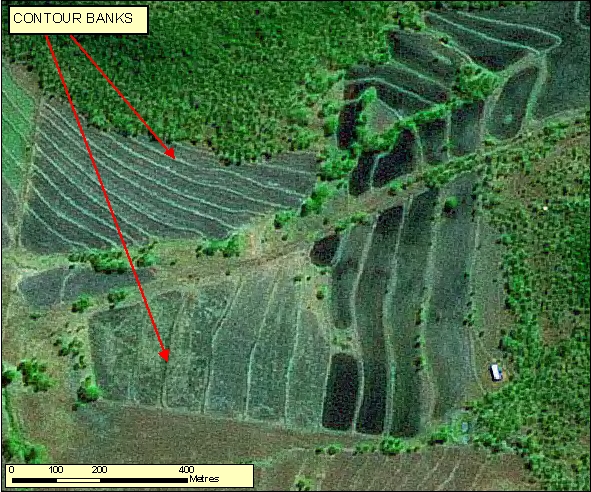
[back to top]
2.3.6.2 Example 2
| |
| Location of Example: |
151°52'05" East, 27°49'33" South |
| Distinctive Characteristics: |
- Contour banks are earthen structures constructed at intervals across cultivated slopes.
- Contour banks intercept run-off and direct it into nearby Drainage or Waterbodies.
- Contour banks can be identified by the small embankments intercepting the fall of the land.
- Contour banks are not to be captured as Canals.
- Canals generally start at a water source and can end at a Reservoir, Dam or Sea.
- Contour banks differ from Canals as Canals transport water in an active manner (via pumping).
|
| Regional Considerations: |
|
| Figure: 2.3.6.2 Representation of Contour Banks. |
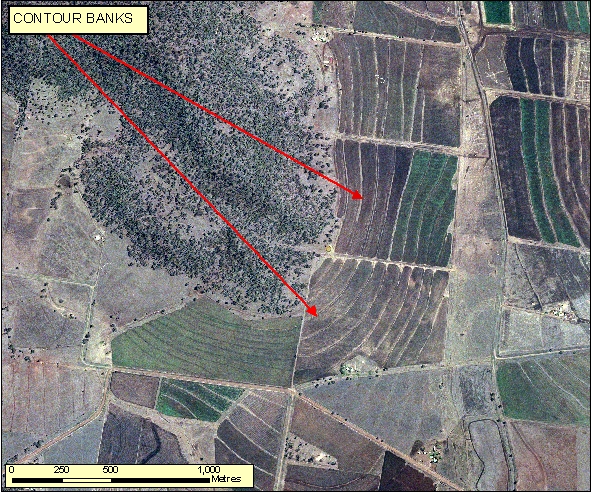
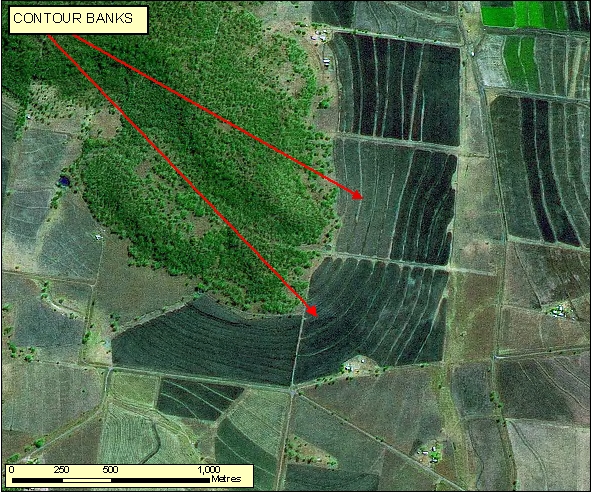
[back to top]
2.3.6.3 Example 3
| |
| Location of Example: |
151°54'47" East, 27°47'37" South |
| Distinctive Characteristics: |
- Contour banks are earthen structures constructed at intervals across cultivated slopes.
- Contour banks intercept run-off and direct it into nearby Drainage or Waterbodies.
- Contour banks can be identified by the small embankments intercepting the fall of the land.
- Contour banks are not to be captured as Canals.
- Canals generally start at a water source and can end at a Reservoir, Dam or Sea.
- Contour banks differ from Canals as Canals transport water in an active manner (via pumping).
|
| Regional Considerations: |
|
| Figure: 2.3.6.3 Representation of Contour Banks. |
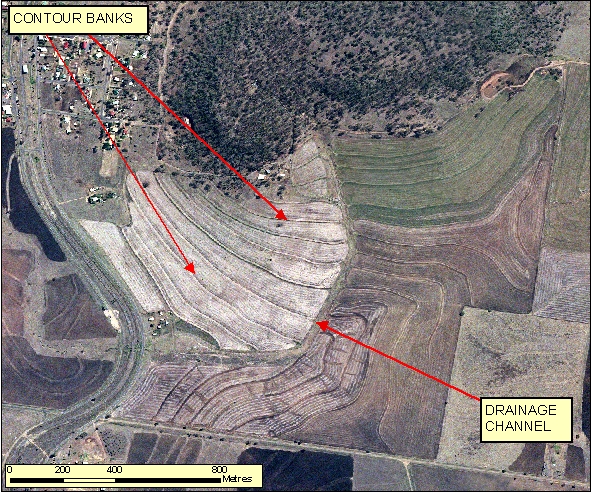
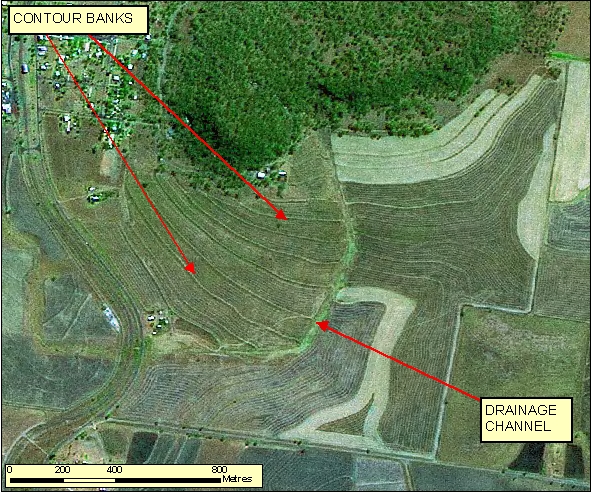
[back to top]
2.3.6.4 Example 4
| |
| Location of Example: |
147°50'08" East, 33°41'36" South |
| Distinctive Characteristics: |
- Contour banks are earthen structures constructed at intervals across cultivated slopes.
- Contour banks intercept run-off and direct it into nearby Drainage or Waterbodies.
- Contour banks can be identified by the small embankments intercepting the fall of the land.
- Contour banks are not to be captured as Canals.
- Canals generally start at a water source and can end at a Reservoir, Dam or Sea.
- Contour banks differ from Canals as Canals transport water in an active manner (via pumping).
|
| Regional Considerations: |
|
| Figure: 2.3.6.4 Representation of Contour Banks. |
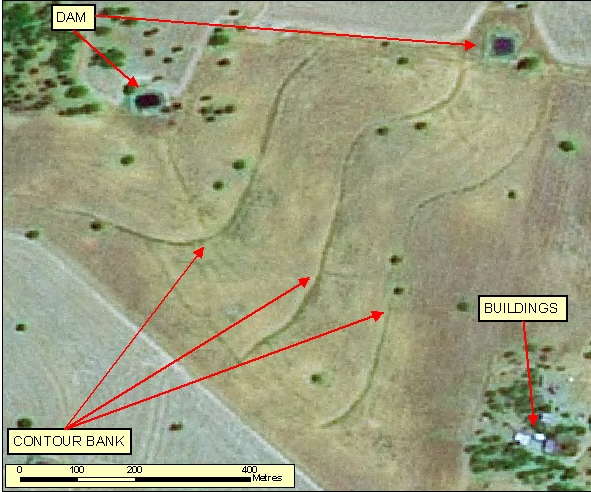
[back to top]
2.3.6.5 Example 5
| |
| Location of Example: |
147°50'08" East, 33°44'46" South |
| Distinctive Characteristics: |
- Contour banks are earthen structures constructed at intervals across cultivated slopes.
- Contour banks intercept run-off and direct it into nearby Drainage or Waterbodies.
- Contour banks can be identified by the small embankments intercepting the fall of the land.
- Contour banks are not to be captured as Canals.
- Canals generally start at a water source and can end at a Reservoir, Dam or Sea.
- Contour banks differ from Canals as Canals transport water in an active manner (via pumping).
|
| Regional Considerations: |
|
| Figure: 2.3.6.5 Representation of Contour Banks. |
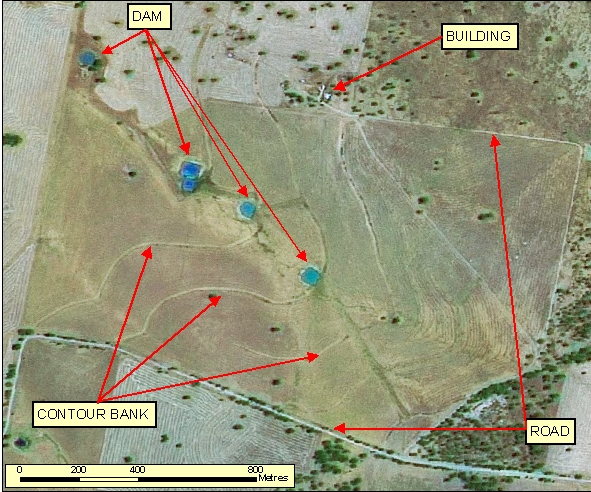
[back to top]
2.3.6.6 Example 6
| |
| Location of Example: |
147°58'44" East, 33°47'21" South |
| Distinctive Characteristics: |
- Contour banks are earthen structures constructed at intervals across cultivated slopes.
- Contour banks intercept run-off and direct it into nearby Drainage or Waterbodies.
- Contour banks can be identified by the small embankments intercepting the fall of the land.
- Contour banks are not to be captured as Canals.
- Canals generally start at a water source and can end at a Reservoir, Dam or Sea.
- Contour banks differ from Canals as Canals transport water in an active manner (via pumping).
|
| Regional Considerations: |
|
| Figure: 2.3.6.6 Representation of Contour Banks. |
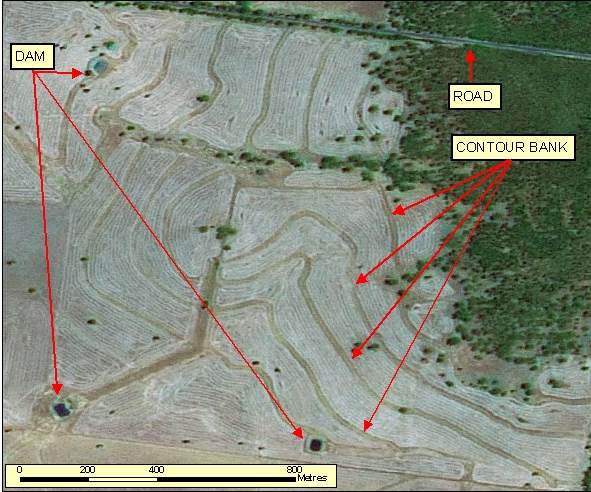
[back to top]
2.3.7 Dams Vs Vegetation
2.3.7.1 Example 1
| |
| Location of Example: |
149°51'51" East, 28°20'51" South, |
| Distinctive Characteristics: |
- Dams can be differentiated from vegetation on thematic imagery by their blue signature compared with the red signature of the vegetation.
- In this example the concentration of similar features is indicative of vegetation.
|
| Regional Considerations: |
|
| Figure: 2.3.7.1 Representation of Vegetation. |
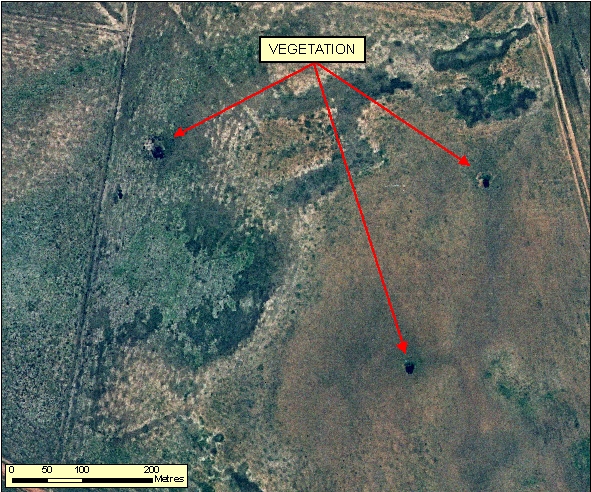
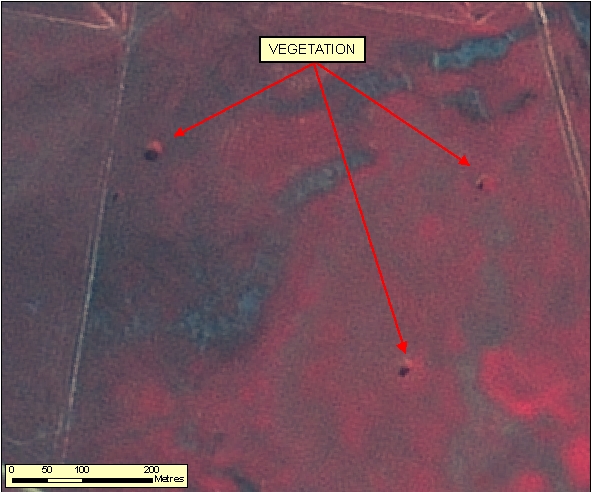
[back to top]
2.3.7.2 Example 2
| |
| Location of Example: |
148°41'09" East, 35°10'57" South, |
| Distinctive Characteristics: |
- Dams can be differentiated from vegetation on thematic imagery by their blue signature compared with the red signature of the vegetation.
- Figure 2.3.7.2a shows two dams near a group of dark green vegetation. Vegetation can often be mistaken for a dam when it is this dark green colour and in an oval shape. Both the dams and the vegetation have unsealed tracks near them providing access.
- Where imagery is course compare existing band signatures between known features and unknown new features to assist in interpretation between vegtation and water.
|
| Regional Considerations: |
|
| Figure: 2.3.7.2 Representation of Vegetation. |
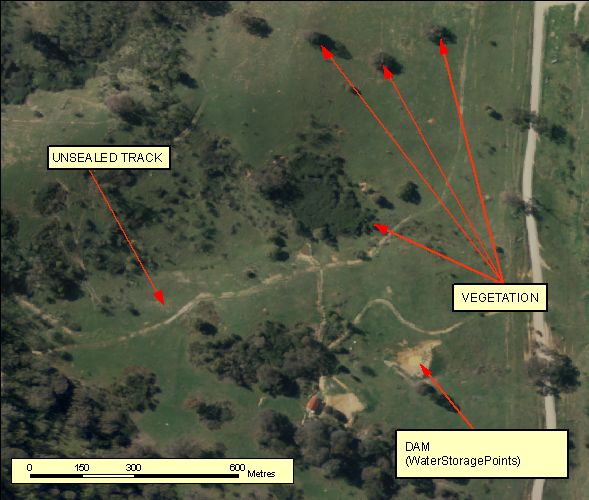
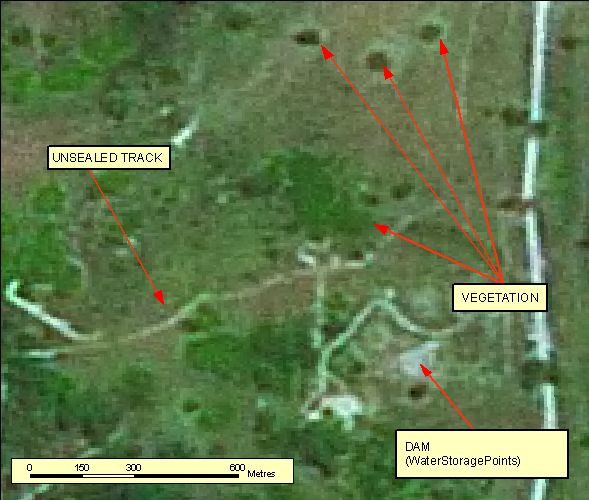
Topic contact: mapfeedback@ga.gov.au Last updated: January 20, 2012































































